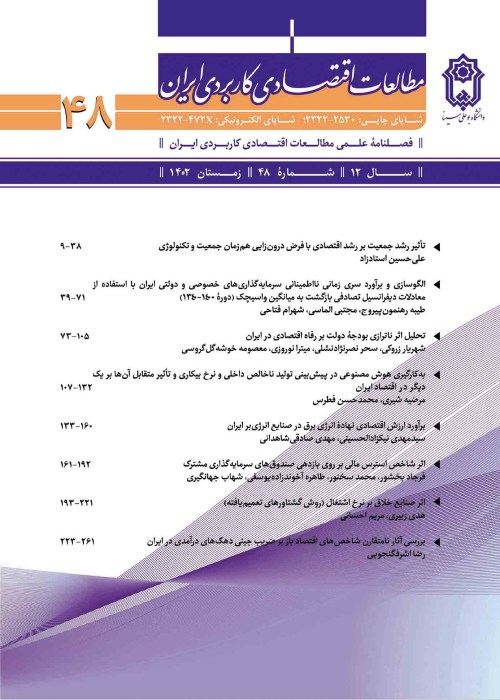Estimation the share of inefficient wage inequality between rural-urban in Iran
Author(s):
Abstract:
Wage differences between two groups can be explained by two factors, difference in human capital and occupational and activity status that observable, and another factor related to discrimination, discrimination is difference in return for equal characteristic, in fact discrimination cannot be explained by differences in characteristics such as education, experience. If the difference in wages was due to human capital difference, because each of the factors of production are paid based on the value of their marginal product. Such as wage gap is efficient and imply on optimal resource allocation. But if wage gap was due to discrimination, wage gap is inefficient. In recent years, one of the most problems in Iran migration of rural people to urban area. One of the reasons for this phenomenon is regional wage gap. The evidence of gathering data from statistical center of Iran show that wage inequality between rural-urban regional is high in 2006 and has decreased in 2014. therefore the goal of this study, the estimation of the share of inefficient wage inequality between rural-urban in Iran by using the data from Households Income and Expenditures surveys over 2006-2014 and applying Oaxaca-Blinder (inequality of wage at mean) and Machado-Mata (inequality of wage at entire distribution) decomposition models.
Theoretical framework :For decomposition wage inequality between rural-urban regional we use of Bakers taste discrimination theory (1957). Becker (1957) introduces the concept of discrimination on the labor market; employers maximize the utility function and have disutility from employing the some group. Equation (1) shows that wage difference can be decompose to two part, first term on the right hand side of equation (1) indicating regional wage gap due to productivity difference and second term due to discrimination.
When the first term has dominant effect, the share of efficient wage gap is high and when the size of second term is high, possibility of inefficient allocation resource has increased.
R in equation 2 is wage gap, x is characteristics component such as experience, education, gender, job and activity statues, β is estimated coefficient of characteristics of labor. The first term on the right hand of equation 2 equal to amounts to the part that is due to differences in characteristics between urban and rural (explained part of the differential), second term is the contribution of differences in coefficients (discrimination component or unexplained part of the differential).
Result and
Theoretical framework :For decomposition wage inequality between rural-urban regional we use of Bakers taste discrimination theory (1957). Becker (1957) introduces the concept of discrimination on the labor market; employers maximize the utility function and have disutility from employing the some group. Equation (1) shows that wage difference can be decompose to two part, first term on the right hand side of equation (1) indicating regional wage gap due to productivity difference and second term due to discrimination.
When the first term has dominant effect, the share of efficient wage gap is high and when the size of second term is high, possibility of inefficient allocation resource has increased.
Methodology
To increasing the concordance between goal of study and theoretical framework we use the decomposition model that suggested by Blinder-Oaxaca (1973) and Machado-Mata (2005). R in equation 2 is wage gap, x is characteristics component such as experience, education, gender, job and activity statues, β is estimated coefficient of characteristics of labor. The first term on the right hand of equation 2 equal to amounts to the part that is due to differences in characteristics between urban and rural (explained part of the differential), second term is the contribution of differences in coefficients (discrimination component or unexplained part of the differential).
Result and
Discussion
The result of study show that total wage gap (difference the logarithm of wage), has decreased from 0.41 in 2006 to 0.28 in 2014, also the efficient wage gap has decreased from 0.299 in 2008 to 0.117 in 2014, and inefficient wage gap has decreased from 0.234 in 2006 to 0.0484 in 2012 and then increased to 0.166 in 2014. But the share of inefficient wage over 2006-2014 was about 37 percent. the result of Machado-Mata decomposition show wage gap in all centile decreased and role of decreasing discrimination in lower centile more than efficient wage gap and in upper centile the role of decreasing efficient wage gap is dominant. Also increasing the migration of rural to urban and increasing competition for finding a job in urban area lead to increasing efficient wage gap in bottom centile in 2014 than 2006. in fact the result show that high wage earner necessary doesnt have high level of human capital. Keywords:
Language:
Persian
Published:
Quarterly Journal of Applied Economics Studiesin Iran, Volume:6 Issue: 22, 2017
Pages:
123 to 143
magiran.com/p1720362
دانلود و مطالعه متن این مقاله با یکی از روشهای زیر امکان پذیر است:
اشتراک شخصی
با عضویت و پرداخت آنلاین حق اشتراک یکساله به مبلغ 1,390,000ريال میتوانید 70 عنوان مطلب دانلود کنید!
اشتراک سازمانی
به کتابخانه دانشگاه یا محل کار خود پیشنهاد کنید تا اشتراک سازمانی این پایگاه را برای دسترسی نامحدود همه کاربران به متن مطالب تهیه نمایند!
توجه!
- حق عضویت دریافتی صرف حمایت از نشریات عضو و نگهداری، تکمیل و توسعه مگیران میشود.
- پرداخت حق اشتراک و دانلود مقالات اجازه بازنشر آن در سایر رسانههای چاپی و دیجیتال را به کاربر نمیدهد.
In order to view content subscription is required
Personal subscription
Subscribe magiran.com for 70 € euros via PayPal and download 70 articles during a year.
Organization subscription
Please contact us to subscribe your university or library for unlimited access!


